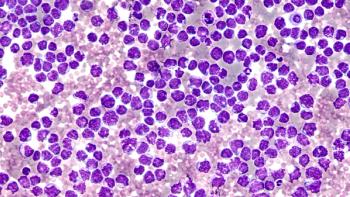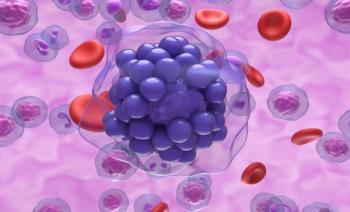
Metabolic Reprogramming Takes Center Stage in Fibrotic Lung Disease
Key Takeaways
- Metabolic reprogramming in fibrotic lung diseases involves key metabolites like lactate, succinate, and 2-hydroxyglutarate, driving inflammation and fibroblast activation.
- Lactate accumulation stabilizes HIF-1α, promoting fibroblast proliferation and epithelial-to-mesenchymal transition, making it a potential therapeutic target.
Metabolic intermediates were identified as active participants in fibrosis progression and potential targets for next-generation therapies.
A recent review in
Fibrotic lung disease is marked by destruction of the alveolar-capillary barrier, excessive fibroblast proliferation, and hypoxia-induced inflammation. As fibrosis progresses, low oxygen levels within the damaged tissue force cells to adapt by switching from energy-efficient oxidative phosphorylation to glycolysis. This metabolic shift, primarily regulated by hypoxia-inducible factor-1α (HIF-1α), creates an excess of metabolic intermediates, particularly lactate and succinate, which further promote the fibrotic process.
Lactate accumulation, previously regarded as a straightforward consequence of hypoxia, now appears to play a more active role in the development of fibrosis.2 Under low-oxygen conditions, the activation of the Akt2–PDK1 pathway redirects energy metabolism, resulting in high levels of lactate that stabilize HIF-1α and perpetuate the glycolytic cycle. In experimental models, lactate buildup triggers activation of growth pathways that promote fibroblast proliferation and epithelial-to-mesenchymal transition.
In patients with IPF, elevated tissue lactate and lactate dehydrogenase-5 have been linked with activation of transforming growth factor-β (TGF-β), a central mediator of fibrosis.3 Lactate also modifies gene expression through histone lactylation, reprogramming macrophages toward a profibrotic state. “Collectively, these findings establish lactate as a key driver of PF and a potential therapeutic target in IPF,” the authors explain.
Similarly, excess succinate, another mitochondrial metabolite, reinforces this cycle of hypoxia and inflammation.1 When the enzyme succinate dehydrogenase malfunctions, succinate accumulates and stabilizes the HIF-1α protein. It also binds to its receptor (SUCNR1) on immune cells, stimulating the release of interleukin-1β (IL-1β) and other pro-inflammatory cytokines. In both preclinical and patient studies, higher serum succinate levels have been associated with more severe fibrosis and worse outcomes in IPF.4
The review also details how L-2-hydroxyglutarate (2-HG), formed during chronic hypoxia, disrupts normal gene regulation. Instead of enzyme accumulation, the metabolite itself interferes with DNA and histone-modifying enzymes, leading to alveolar epithelial cell death and sustained fibroblast activation.1 This cascade suppresses PGC-1α, further compromising the cell’s energy balance and resilience. The result is a self-sustaining loop of oxidative stress, energy depletion, and tissue scarring.
Beyond these metabolic intermediates, the review also points to abnormalities in lipid metabolism. Hypoxia activates phospholipase A₂, which breaks down essential surfactant phospholipids such as phosphatidylcholine and phosphatidylethanolamine. The resulting products, including lysophosphatidic acid (LPA), activate signaling pathways such as MAPK/ERK and PI3K/Akt, thereby further stimulating fibroblast activity and inducing apoptosis in epithelial cells. These processes degrade surfactant integrity and mitochondrial lipid membranes, further compounding tissue injury.
Despite progress with approved antifibrotic agents, pirfenidone and nintedanib, current therapies primarily slow disease progression and often cause adverse effects. As a result, researchers are exploring therapies that directly target metabolic pathways implicated in fibrosis.
One promising approach involves blocking lactate export via the monocarboxylate transporter 4 (MCT4). In preclinical models, the inhibitor VB253 reduced fibroblast activation and reactive oxygen species production.5 Another agent, IR-780, limits succinate accumulation by modulating the succinate dehydrogenase complex and has shown antifibrotic effects in animal studies.1
Other small molecules, including itaconate, 4-octyl itaconate (4-OI), and dimethyl fumarate (DMF), activate the antioxidant regulator NRF2, decrease inflammation, and restore mitochondrial balance. DMF, already used in the treatment of multiple sclerosis and psoriasis, has demonstrated protective effects in pulmonary fibrosis animal models.6 Additionally, sirtuin (SIRT1) activators such as resveratrol and NAD⁺ precursors may help restore mitochondrial function and suppress profibrotic signaling.1
The accumulating evidence positions metabolism as a central driver and modifiable target of fibrotic lung disease. Metabolites once considered simple byproducts are now recognized as active participants in cellular signaling, inflammation, and epigenetic control. Investigators suggest that “Targeting themetabolites involved in pathological pathways with small molecule‐mediated therapies such as VB253, IR‐780, 4‐OI, DMF, and SIRTs can be explored to expand treatment options through their exhaustive mechanistic investigations and successful trials in preclinical and clinical settings.”
References
1. Kumari S, Singh K, Khadia M, Kumar R, Bansal V, Mishra A. Exploring the influence of metabolic changes in fibrotic lung diseases. Pulm Circ. 2025;15(3):e70163. doi:10.1002/pul2.70163
2. Liang H, Xu L, Yang Y. Lactate and lactylation: novel perspectives on fibrosis pathogenesis and therapeutic directions. J Transl Med. 2025;23(1):705. doi:10.1186/s12967-025-06748-0
3. Kottmann RM, Kulkarni AA, Smolnycki KA, et al. Lactic acid is elevated in idiopathic pulmonary fibrosis and induces myofibroblast differentiation via pH-dependent activation of transforming growth factor-β. Am J Respir Crit Care Med. 2012;186(8):740-51. doi:10.1164/rccm.201201-0084OC
4. He Y, Han Y, Zou L, et al. Succinate promotes pulmonary fibrosis through GPR91 and predicts death in idiopathic pulmonary fibrosis. Sci Rep. 2024;14(1):14376. doi:10.1038/s41598-024-64844-5
5. Ziehr DR, Li F, Parnell KM, et al. Lactate transport inhibition therapeutically reprograms fibroblast metabolism in experimental pulmonary fibrosis. Published April 28, 2024. doi:10.1101/2024.04.25.591150
6. Bresciani G, Manai F, Davinelli S, Tucci P, Saso L, Amadio M. Novel potential pharmacological applications of dimethyl fumarate-an overview and update. Front Pharmacol. 2023;14:1264842. doi:10.3389/fphar.2023.1264842
Newsletter
Stay ahead of policy, cost, and value—subscribe to AJMC for expert insights at the intersection of clinical care and health economics.













































